From Art to Science: How Advanced Cast Iron Simulation Delivers Predictable Performance and Quality
This technical summary is based on the academic paper "Cast iron - a predictable material" by Jörg C. Sturm and Guido Busch, published in The 69th WFC Paper (2011).
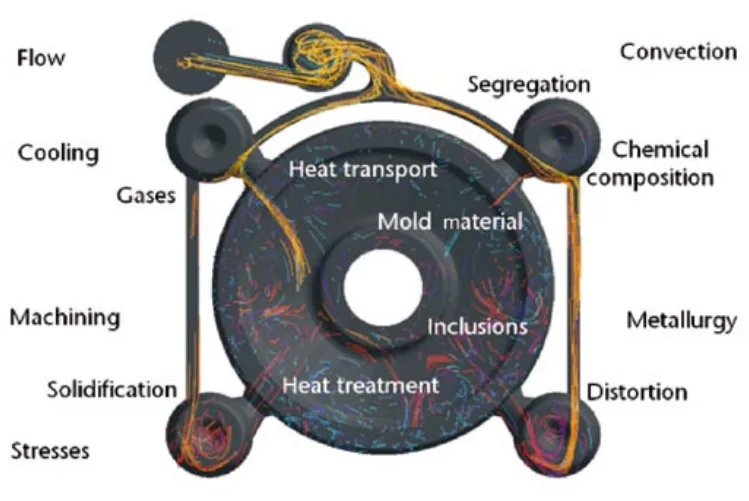
![Fig. 4: Set-up of methoding for ductile iron compressor housing. Based on the raw part CAD-model (a) a quick assessment of local thermal modulus was done (b) to determine the gating and risering lay-out (positions of chills and feeders). Subsequently the entire lay-out is simulated. Mold filling (c) and solidification (d) can be predicted quantitatively [7].](https://castman.co.kr/wp-content/uploads/image-3403.webp)
Keywords
- Primary Keyword: Cast Iron Simulation
- Secondary Keywords: Casting Process Simulation, Casting Defect Prediction, Residual Stress Analysis, Microstructure Modeling, ADI Heat Treatment, Casting Performance
Executive Summary
- The Challenge: Foundries face immense pressure to shorten lead times and reduce costs while meeting increasingly demanding technical requirements for cast iron components.
- The Method: The research utilizes advanced casting process simulation that integrates micromodels, which account for alloy composition, metallurgy, and mass transport, to go beyond simple thermal analysis.
- The Key Breakthrough: This simulation approach can quantitatively predict not just hot spots, but specific defects, local microstructures, final mechanical properties, and residual stresses throughout the entire manufacturing route, including complex heat treatments.
- The Bottom Line: Advanced cast iron simulation transforms the material from an empirical art into a predictable science, enabling foundries to optimize processes, guarantee quality, and provide designers with reliable data for high-performance components.
The Challenge: Why This Research Matters for HPDC Professionals
The metal casting industry is in a constant balancing act between technical demands and commercial viability. Clients are globalizing, outsourcing responsibilities, and demanding shorter lead times and lower costs. For cast iron, this is a significant challenge. Its solidification behavior is highly dependent on metallurgy, melting practice, and inoculation, making defects like shrinkage difficult to predict with traditional methods. Simple hot-spot analysis based on temperature fields is often insufficient, as it fails to account for the unique expansion effects of graphite precipitation in ductile iron. This uncertainty can lead to costly trial-and-error on the shop floor, casting distortion, unexpected cracks, and a general lack of confidence from designers who need predictable material performance for critical applications.
The Approach: Unpacking the Methodology
To make cast iron truly predictable, the study moves beyond macroscopic heat flow simulation and employs a methodology based on integrated micromodels. This approach treats the casting process not just as a thermal problem, but as a complex interaction of physics, metallurgy, and chemistry.
Method 1: Microstructure-Based Solidification Modeling
Instead of using fixed thermo-physical properties for an alloy, this method determines properties at each time step and location as a function of the current phase formation. The simulation takes inputs like melt quality, inoculation, and alloy composition to model the kinetics of phase formation (graphite, austenite, cementite). This allows it to accurately simulate local cooling curves, including undercooling and recalescence, which are critical for predicting the final microstructure and feeding behavior (Fig. 3).
Method 2: Coupled Stress and Distortion Analysis
The methodology includes state-of-the-art tools for predicting thermally driven stresses and distortion. It models the entire cooling process down to ambient temperature, accounting for stress inversions where a section under tensile stress at high temperatures (and prone to cracking) can end up in a compressive state at room temperature. This analysis can also simulate the stress redistribution that occurs after machining or removal of the gating system.
Method 3: Full Manufacturing Route Simulation for ADI
For advanced materials like Austempered Ductile Iron (ADI), the methodology simulates the entire three-step heat treatment process. It uses the as-cast microstructure predicted from the initial casting simulation as the input for modeling the austenitization, quenching, and ausferritization stages. Coupled diffusion and kinetic models predict the formation of ausferrite and the stabilization of high-carbon austenite, which are essential for achieving the desired final properties.
The Breakthrough: Key Findings & Data
The application of this comprehensive simulation methodology yields quantitative, actionable predictions that directly address the core challenges of cast iron manufacturing.
Finding 1: Quantitative Prediction of Shrinkage Defects
The simulation accurately predicts porosity by calculating the local sum of shrinkage and expansion. As shown in Figure 5, a simple heat flow calculation for a ductile iron ring casting would only show a ring-shaped temperature distribution, failing to predict the secondary shrinkage below the risers. The micromodel, by combining local shrinking (liquid, austenite) and expansion (graphite) behavior, correctly identifies the defect. Figure 7 further demonstrates this by showing how simulation correctly identifies porosity in a riserless grey iron casting and confirms that a small riser completely compensates for the liquid shrinkage.
Finding 2: Accurate Prediction of Local Microstructure and Mechanical Properties
The simulation provides detailed predictions of the final microstructure. Figure 9 shows a quantitative prediction of the ferrite/pearlite distribution in a ductile iron hub, with the simulation results closely matching experimental findings at a customer site. This knowledge of local phases allows for the direct prediction of mechanical properties. As seen in Figure 11, the simulated hardness values for an exhaust manifold in a Si-Mo alloy show a strong correlation with the measured hardness values on the actual casting.
Finding 3: Reliable Prediction of Distortion and Stress-Related Cracks
The models can effectively predict and help mitigate distortion and cracking. Figure 13 details a case where an initial rigid gating system caused unacceptable distortion in a grey iron housing. The simulation was used to design a modified gating system that met distortion specifications while still ensuring robust filling and solidification. Furthermore, Figure 14 shows how simulation identified high residual stresses and strain rates around a valve stem hole in a wheel weight, correctly predicting the location of cracks that only appeared after mounting, even though the as-cast part appeared defect-free.
Paper Details
Cast iron - a predictable material
1. Overview:
- Title: Cast iron - a predictable material
- Author: *Jörg C. Sturm and Guido Busch (MAGMA Gießereitechnologie GmbH, Aachen, Germany)
- Year of publication: 2011
- Journal/academic society of publication: The 69th WFC Paper
- Keywords: casting process simulation; cast iron; defects; casting performance; development
2. Abstract:
High strength compacted graphite iron (CGI) or alloyed cast iron components are substituting previously used non-ferrous castings in automotive power train applications. The mechanical engineering industry has recognized the value in substituting forged or welded structures with stiff and light-weight cast iron castings. New products such as wind turbines have opened new markets for an entire suite of highly reliable ductile iron cast components. During the last 20 years, casting process simulation has developed from predicting hot spots and solidification to an integral assessment tool for foundries for the entire manufacturing route of castings. The support of the feeding related layout of the casting is still one of the most important duties for casting process simulation. To be able to quantitatively predict these defects, solidification simulation had to be combined with density and mass transport calculations, in order to evaluate the impact of the solidification morphology on the feeding behavior as well as to consider alloy dependent feeding ranges. For cast iron foundries, the use of casting process simulation has become an important instrument to predict the robustness and reliability of their processes, especially since the influence of alloying elements, melting practice and metallurgy need to be considered to quantify the special shrinkage and solidification behavior of cast iron. This allows the prediction of local structures, phases and ultimately the local mechanical properties of cast irons. Casting quality issues related to thermally driven stresses in castings are also gaining increasing attention. State-of-the-art tools allow the prediction of residual stresses and iron casting distortion quantitatively. As the property requirements for cast iron as a material in design strongly increase, new alloys and materials such as ADI might become more attractive, where latest software developments allow the modeling of the required heat treatment. All this quantitative information about the material's performance is most valuable if it can be used during casting design. The transfer of local properties into the designer's world, to predict fatigue and durability as a function of the entire manufacturing route, will increase the trust in this old but highly innovative material and will open new opportunities for cast iron in the future. The paper will give an overview on current capabilities to quantitatively predict cast iron specific defects and casting performance and will highlight latest developments in modeling the manufacture of cast iron and ADI as well as the prediction of iron casting stresses.
3. Introduction:
The metal casting industry continually seeks to balance technical and commercial requirements, maintaining engineering capabilities while ensuring operational efficiency and profitability. The current commercial environment is characterized by decentralization, with clients outsourcing responsibilities and globalizing their operations. Consequently, the technical requirements and scope of responsibility for metal casters have become more demanding, necessitating new approaches to shorten lead times, reduce total costs, and enhance technical interaction with clients. Casting process simulation has emerged as a critical tool in this context, enabling foundries to optimize processes and predict component properties. This is particularly relevant for cast iron, where substitution of processes and materials is a growing challenge. The technology has evolved to a point where it can transparently model the complex interactions of physics, metallurgy, and chemistry, transforming an empirically driven process into a first-principle-based manufacturing method.
4. Summary of the study:
Background of the research topic:
The manufacturing of cast iron components, including ductile iron, compacted graphite iron (CGI), and austempered ductile iron (ADI), requires a profound understanding of the material and process robustness to meet modern specifications. The material's solidification and feeding behavior are strongly dependent on alloy composition, melting practice, and metallurgy, making traditional prediction methods based solely on thermal analysis insufficient.
Status of previous research:
Over the past two decades, casting process simulation has evolved from simple hot spot and solidification prediction to an integral assessment tool. However, early approaches were not sufficient for cast iron, as they could not account for the complex interplay between local cooling conditions, metallurgical factors (like inoculation), and the resulting phase transformations that dictate shrinkage, expansion, and final microstructure.
Purpose of the study:
This paper aims to provide an overview of the current capabilities of casting process simulation to quantitatively predict cast iron-specific defects, casting performance, and stresses. It highlights recent developments in modeling the entire manufacturing route, including heat treatment for materials like ADI, and demonstrates how this quantitative information can be integrated into the component design process to increase trust and open new opportunities for cast iron.
Core study:
The study presents a simulation methodology for cast iron that incorporates microstructure models ("micromodels"). These models consider inputs such as alloy composition, inoculation, and local cooling rates to predict the kinetics of phase formation during solidification and solid-state transformations. This allows for the quantitative prediction of:
1. Feeding-related defects: By calculating the net effect of liquid/austenite contraction and graphite expansion.
2. Microstructures: Including eutectic cell/nodule count, nodularity, graphite morphology, and ferrite/pearlite distribution.
3. Mechanical properties: Such as hardness, tensile strength, and elongation, derived from the predicted microstructure.
4. Thermally induced stresses and distortion: Including residual stresses, hot tearing susceptibility, and the effects of post-casting operations like machining.
5. Heat treatment outcomes: Specifically for ADI, modeling the phases developed during austenitization, quenching, and ausferritization.
The paper validates these predictive capabilities through comparisons with experimental data and industrial case studies involving components like compressor housings, engine blocks, and exhaust manifolds.
5. Research Methodology
Research Design:
The research is presented as a review of the state-of-the-art in casting process simulation technology, supported by a series of case studies and validation examples. The approach is descriptive and illustrative, demonstrating the capabilities of the simulation tools by applying them to real-world industrial components and comparing the predicted outcomes with measured results.
Data Collection and Analysis Methods:
The methodology relies on a computational simulation framework. This framework combines finite element/finite difference methods for solving heat transfer and stress equations with specialized micromodels for predicting metallurgical phenomena. The micromodels are based on physical principles of nucleation, growth, segregation, and diffusion. Validation is achieved by comparing simulation outputs (e.g., predicted hardness, nodularity, defect locations, distortion) with experimental measurements obtained from sectioned castings, mechanical testing, and production data from foundries.
Research Topics and Scope:
The scope of the research covers the entire manufacturing process for various grades of cast iron, from mold filling to final properties after heat treatment. Key topics include:
- Simulation of solidification and feeding behavior.
- Prediction of shrinkage porosity.
- Modeling of microstructure evolution (graphite morphology, matrix phases).
- Prediction of local mechanical properties.
- Analysis of residual stress, distortion, and crack formation.
- Simulation of the complete ADI heat treatment process.
- Integration of simulation results into the component design and performance analysis chain (CAE).
6. Key Results:
Key Results:
- Casting process simulation using micromodels can quantitatively predict shrinkage defects in cast iron by accounting for both contraction of metallic phases and expansion due to graphite precipitation, which is not possible with simple thermal analysis.
- The simulation can accurately predict local microstructural features, such as nodularity in CGI, ferrite/pearlite distribution in ductile iron, and the transition to white solidification, as a function of alloy composition, inoculation, and cooling conditions.
- Local mechanical properties, such as hardness, can be predicted with a high degree of accuracy across the entire casting, matching well with experimental findings on industrial parts.
- The modeling of thermally induced stresses allows for the quantitative prediction of casting distortion, residual stress levels, and susceptibility to cracking, enabling the optimization of gating design and process parameters to mitigate these issues.
- The entire manufacturing route, including multi-stage heat treatments for ADI, can be simulated. This allows for the optimization of process parameters like austenitization time, quenching rates, and austempering time to achieve the desired ausferritic matrix without forming undesirable phases.
- The integration of predicted local properties and residual stresses into structural analysis (CAE) provides a more accurate assessment of component durability and fatigue life compared to analyses that assume uniform material properties.
Figure Name List:
- Fig. 1: A challenging task: simulating the casting process to predict component properties.
- Fig. 2: Modeling of the casting process for cast iron based on micromodels.
- Fig. 3: Sensitivity of cast iron micromodels to the metal treatment applied.
- Fig. 4: Set-up of methoding for ductile iron compressor housing.
- Fig. 5: Predicting shrinkage in cast iron components.
- Fig. 6: Shrinkage prediction and reality.
- Fig. 7: Is a riser needed or not?
- Fig. 8: Simulating the influence of alloying elements on the microstructure.
- Fig. 9: Assessment of microstructures and mechanical properties for ductile iron.
- Fig. 10: Simulating local nodularity as a function of alloy, metallurgy and cooling conditions.
- Fig. 11: Comparison of simulated and measured hardness values.
- Fig. 12: Residual stresses in cast iron parts shown using the distortion of a stamping press tool.
- Fig. 13: Optimization of a gating system design leads to reduction of casting distortion.
- Fig. 14: Crack formation in wheel weights.
- Fig. 15: Prediction of crack sensitive area prior to and after machining.
- Fig. 16: Stress relief of cast iron components during heat treatment.
- Fig. 17: Integration of casting process simulation and heat treatment simulation to predict ADI structures.
- Fig. 18: Simulation of austenitization of a planet carrier.
- Fig. 19: Simulation of quenching.
- Fig. 20: Simulation of ausferritization.
- Fig. 21: Casting process simulation strongly supports the development of wind power casting technology.
- Fig. 22: Integrated CAE design-process chain.
- Fig. 23: Impact of as-cast residual stresses on durability of a cast iron engine block.
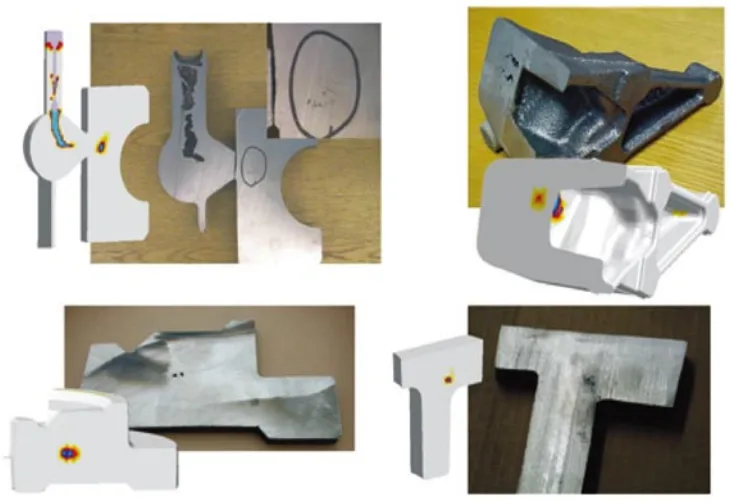
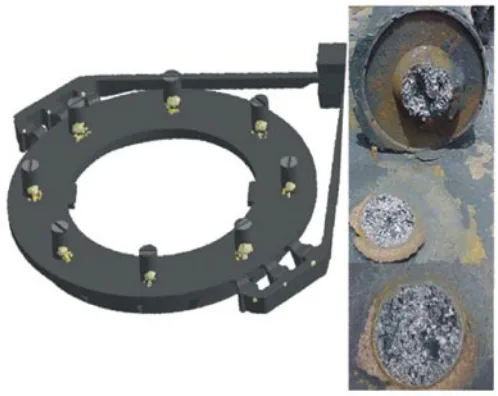
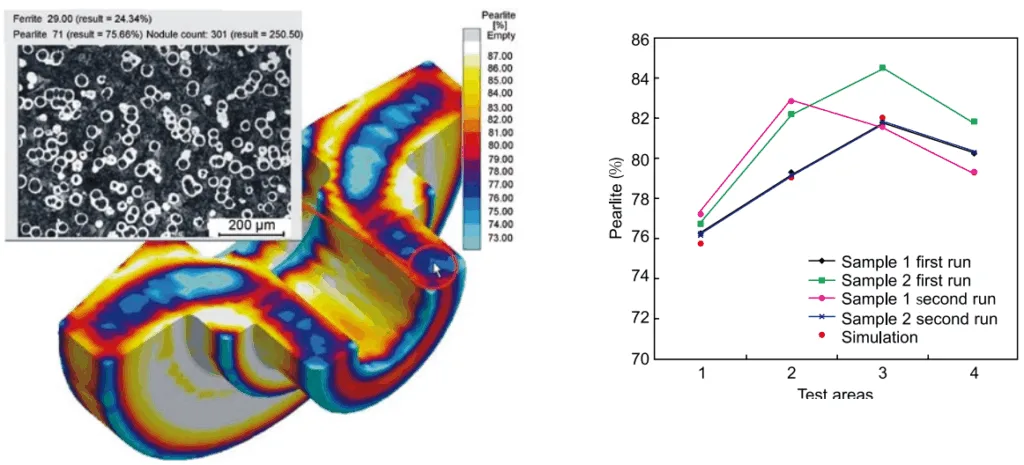
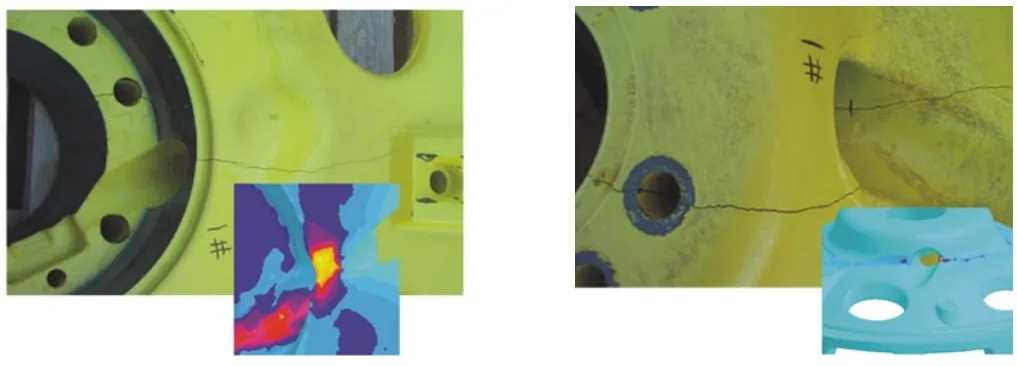
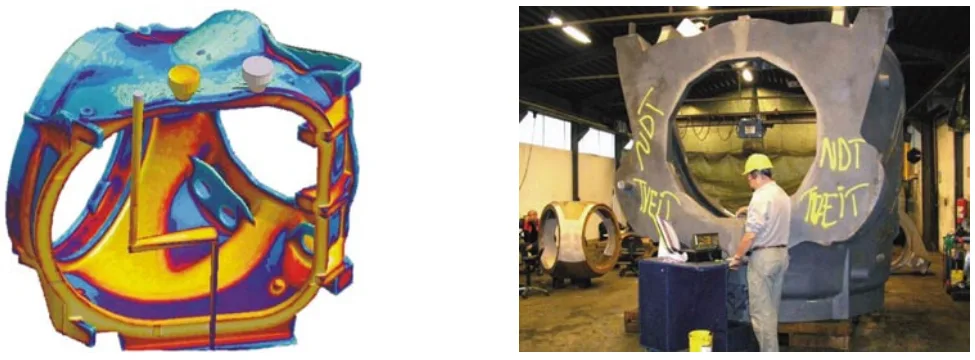
![Fig. 23: Impact of as-cast residual stresses on durability of a cast iron engine block. The classical life time prediction does not consider stresses resulting from manufacturing. The stress free casting shows a safety margin of 130% in a critical area (left). If residual stresses from the casting process are considered as an additional load, the safety margin in the critical area drops down to 80% (right). On the other hand, compressive residual stresses will increase the durability [12].](https://castman.co.kr/wp-content/uploads/image-3409.webp)
7. Conclusion:
State-of-the-art casting process simulation tools provide foundries with the means to achieve reproducible quality, increase profitability, and design for manufacturability. By implementing micromodels that account for the complexities of cast iron solidification, the software can quantitatively predict defects, microstructures, mechanical properties, and stresses. This information supports the component designer in creating designs that leverage the full potential of the material and process, and it supports the foundry specialist in establishing a robust manufacturing route. The ability to predict the performance of the final component as a function of the entire manufacturing process increases trust in cast iron as a highly innovative material and strengthens the competitiveness of the casting process.
8. References:
- [1] Hansen P N, Flender E and Sturm J C. Casting Process Simulation - From the Idea 30 Years ago to Reality Today. International Foundry Research, 2009, 61(4): 12-29.
- [2] Sturm J C. Die Prozess-Entwicklungs-Kette: Nutzung von Eigenschafts-Vorhersagen für Gusseisenwerkstoffe für innovative Bauteil-Konstruktionen. Giesserei, 1990 (9): 56-58.
- [3] Svensson I L, Wessén M. Foundry of Cast Irons: Processing and Simulation. Numerical Simulation of Foundry Processes, 2001 (9): 87-145.
- [4] Heisser C, Sturm J C. Casting Process Simulation of Compacted Graphite Iron (03-025). In: Proceedings of the 107th Casting Congress, Milwaukee, Wisconsin, April 26-28, 2003: 685-692.
- [5] Heisser C, Nikolov K, Burkhardt R. Applying Experience and Technology Tools to Meet Customer Performance Requirements on a 100-70-03 - Ductile Iron Casting (03-120). In: Proceedings of the 107th Casting Congress, Milwaukee, Wisconsin, April 26-28, 2003: 931-937.
- [6] Sturm J C. Optimisation - Integration - Casting Property Prediction. 66th World Foundry Congress, Istanbul, Turkey, September6-9, 2004: 171-168.
- [7] Rechsteiner A. Virtuelles Giessen-ein Werkzeug der täglichen Praxis. In: Proceedings of German MAGMA User Meeting, Vaals, The Netherlands, October 2003,
- [8] Weiss U, Broda M, Rong P. Die Rolle des Eisengießers bei der virtuellen Produktentwicklung im Automobilbau. Presentation on the MAGMA Seminar "Gusseisen Ein Werkstoff mit Zukunft", Duisburg, May 2002.
- [9] Boulton A J, Wieckowicz P, Olive S. Cast Metals Times. Modern Media Communication Ltd, Shordham by sea, UK, June 2003.
- [10] Hansen P N, Hartmann G, Sturm J C. Optimised Development for Castings and Casting Processes Increase in Value by applying an integrated CAE Chain for the Development of Automotive Castings. In: Proceedings of the 65th World Foundry Congress, Kyongju, Korea, October 2002: 625-638.
- [11] Simon W, Weiss U. Gussteilentwicklung im Zeichen neuartiger Anforderungen. In: Proceedings of NEWCAST-Forum, Düsseldorf: "Konstruieren mit Gusswerkstoffen", June 18, 2003: 3-11.
- [12] McClory B, Nguyen W, Heisser C. Effect of Simulated Material Properties and Residual Stresses on High Cycle Fatigue Prediction in a Compacted Graphite Iron Engine Block. In: Proceedings of 2010 Society of Automotive Engineers (SAE) -Conference, Devlin, USA, Dec. 3, paper No: 2010-01-0016.
Expert Q&A: Your Top Questions Answered
Q1: How does this simulation approach for cast iron differ from standard solidification modeling for other alloys?
A1: Standard modeling often relies on macroscopic heat transfer and a simple temperature-based criterion for shrinkage. For cast iron, this is insufficient. The presented methodology incorporates micromodels that simulate the competitive phase formation of austenite (which shrinks) and graphite (which expands). This allows for a quantitative prediction of net volume change and feeding behavior, which is critical for accurately predicting porosity in ductile and grey irons.
Q2: Can the simulation account for variations in melt quality from one batch to another?
A2: Yes, the model is designed to be sensitive to metallurgical inputs. As stated in the paper, parameters like inoculation practice and alloy composition are key inputs for the micromodels (Fig. 2). By adjusting these inputs to reflect the specific metal treatment, the simulation can predict resulting differences in undercooling, nodule count, and graphite morphology, as shown in the simulated cooling curves in Figure 3.
Q3: How reliable is the prediction of mechanical properties like hardness?
A3: The prediction is highly reliable because it is a direct result of the accurately predicted local microstructure. The simulation first calculates the local cooling rates and segregation, which determines the final ferrite/pearlite distribution and other phases. These microstructural outputs are then used to calculate mechanical properties. Figure 11 provides a direct validation, showing a close match between simulated hardness values and those measured on a production Si-Mo alloy exhaust manifold.
Q4: The paper mentions predicting cracks. How does the simulation distinguish between a high-stress area and an actual crack?
A4: The simulation predicts susceptibility to cracking by identifying areas where critical thresholds are exceeded. For hot tearing, it identifies regions with high strains and strain rates during solidification when the material is brittle. For cold cracks, it calculates residual stress levels and compares them to the material's strength. As shown in the wheel weight example (Fig. 14), the simulation identified a damaged area with high residual stresses that, while not cracking during cooling, failed once an external load was applied.
Q5: Is the simulation of the ADI heat treatment just a thermal simulation, or does it model the underlying metallurgy?
A5: It models the full metallurgy, not just the thermal profile. The paper explains that it is a multi-stage simulation that uses the as-cast microstructure as a starting point. It then models diffusion and kinetics to predict carbon saturation during austenitization, the avoidance of pearlite during quenching (Fig. 19), and finally the transformation of austenite into acicular ferrite and stabilized high-carbon austenite during the ausferritization step (Fig. 20).
Q6: What is the main benefit of integrating these simulation results into the designer's CAE tools?
A6: The main benefit is a far more accurate prediction of the component's real-world performance. Instead of assuming uniform, textbook material properties, the designer can use a map of local properties (strength, modulus) and as-cast residual stresses from the simulation. As Figure 23 demonstrates, including residual stresses in a fatigue analysis of an engine block changed the safety margin in a critical area from 130% (safe) to 80% (failure), highlighting how manufacturing effects can dramatically impact durability.
Conclusion: Paving the Way for Higher Quality and Productivity
The persistent challenge in cast iron production has been managing the material's inherent process sensitivity to deliver consistent, high-quality components. This paper demonstrates a key breakthrough: advanced Cast Iron Simulation makes the material's behavior predictable. By modeling the deep metallurgical interactions of solidification, phase transformation, and thermal stress, foundries can move from reactive problem-solving to proactive process optimization. This capability allows engineers to virtually eliminate shrinkage, control microstructure to guarantee mechanical properties, and design gating systems that minimize harmful distortion and residual stress, all before a single mold is made.
"At CASTMAN, we are committed to applying the latest industry research to help our customers achieve higher productivity and quality. If the challenges discussed in this paper align with your operational goals, contact our engineering team to explore how these principles can be implemented in your components."
Copyright Information
This content is a summary and analysis based on the paper "Cast iron - a predictable material" by "Jörg C. Sturm and Guido Busch".
Source: Article ID: 1672-6421(2011)01-051-11
This material is for informational purposes only. Unauthorized commercial use is prohibited.
Copyright © 2025 CASTMAN. All rights reserved.